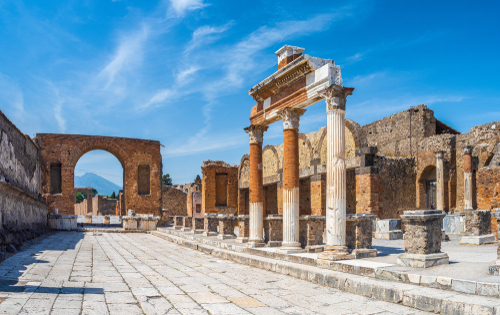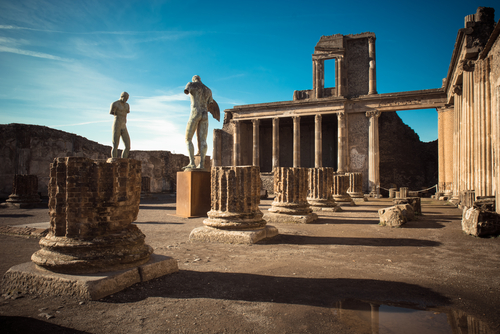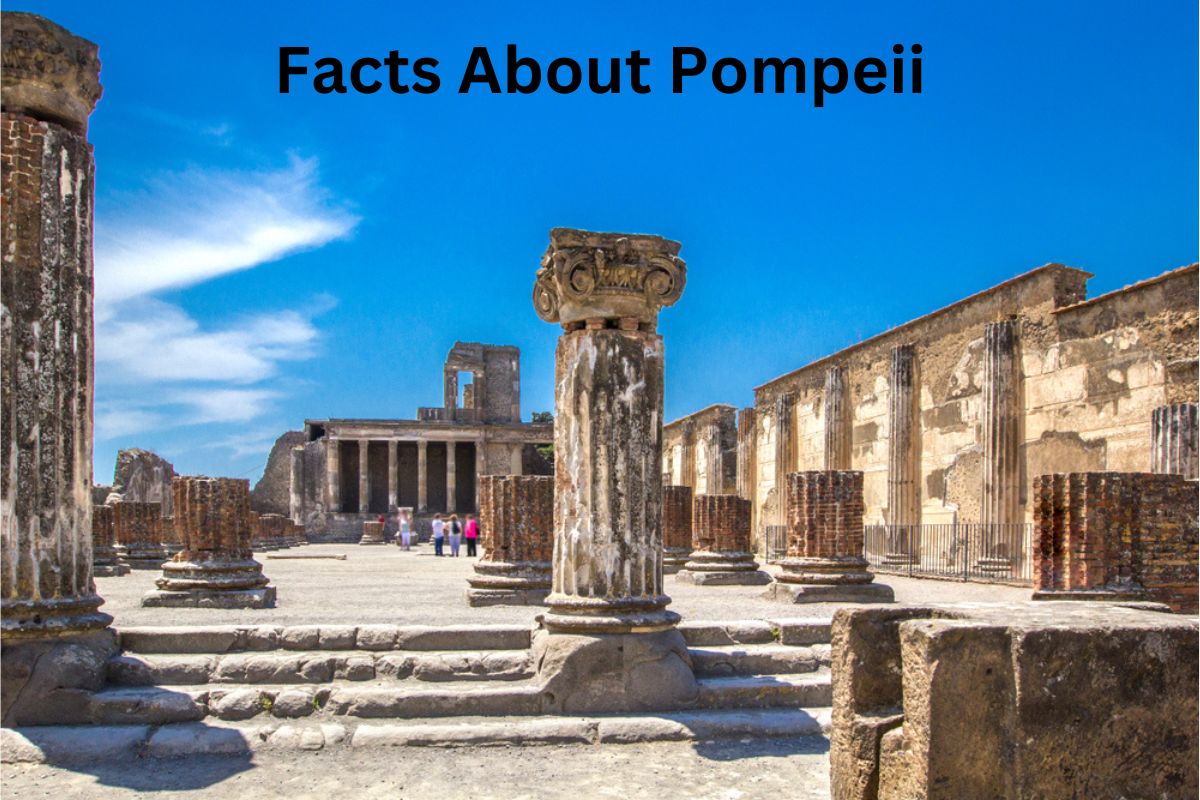Pompeii was an ancient Roman city located near modern-day Naples, Italy. Founded in the 6th century BCE, it thrived as a prosperous commercial center until its devastating destruction by the eruption of Mount Vesuvius in 79 CE.
Buried under layers of ash and forgotten for centuries, Pompeii was rediscovered in the 18th century. Its remarkably preserved ruins offer a remarkable window into daily life in ancient Rome, showcasing its art, architecture, infrastructure, and cultural practices.
Today, Pompeii stands as a UNESCO World Heritage Site, captivating visitors and providing invaluable insights into the ancient world.
Pompeii Facts
1. Pompeii was an ancient Roman city located near modern-day Naples in Italy
Pompeii was an ancient Roman city located near modern-day Naples in Italy. It was founded around the 6th century BCE by the Oscan people, an ancient Italic tribe.
The city was strategically positioned near the Bay of Naples and served as a bustling port, connecting it to trade routes and facilitating commerce with other Mediterranean regions.

2. The eruption of Mount Vesuvius in 79 CE buried the city under a layer of ash and volcanic debris
The eruption of Mount Vesuvius in 79 CE was a catastrophic event that led to the destruction of Pompeii. Mount Vesuvius, a volcanic mountain located about 9 kilometers (5.6 miles) from the city, erupted violently, releasing a massive column of ash, pumice, and volcanic gases into the atmosphere.
The volcanic materials rained down on Pompeii, burying the city under several meters of debris. The eruption happened suddenly, catching the residents off guard, and many were unable to escape in time.
3. Pompeii was a thriving city in ancient Rome, with a population estimated to be around 20,000
Pompeii was a thriving and prosperous city in ancient Rome. It was known for its economic prosperity, driven primarily by its strategic location for trade and its fertile agricultural lands. The city had a thriving economy based on various industries, including agriculture, fishing, manufacturing, and commerce.
Pompeii’s proximity to the Bay of Naples allowed for easy access to maritime trade, and the city served as a hub for the distribution of goods throughout the region. The fertile volcanic soil around Pompeii supported the cultivation of crops such as grapes, olives, and wheat, contributing to its agricultural success.
Additionally, Pompeii’s favorable location made it a popular destination for wealthy Romans who built luxurious villas and vacation homes in the area.
4. The ruins of Pompeii provide a unique snapshot of daily life in ancient Rome
The ruins of Pompeii provide a remarkable glimpse into daily life in ancient Rome. The well-preserved buildings, streets, and artifacts offer valuable insights into various aspects of Roman culture and society.
The architecture of Pompeii reflects a blend of Greek and Roman influences. The city was laid out in a grid pattern with narrow streets and alleys, lined with a mix of modest houses and grand villas.
The houses often featured atriums, courtyards, and gardens, while the wealthier residents had elaborate frescoes, mosaics, and intricate decorations adorning their interiors.

5. Pompeii had a well-developed infrastructure
Pompeii had a sophisticated infrastructure for its time. The city had an advanced water system that supplied water to its residents through a network of aqueducts, pipes, and fountains.
Public baths, known as thermae, were an integral part of Roman culture, and Pompeii boasted several of these grand bathing complexes, such as the Stabian Baths and the Forum Baths.
These baths provided opportunities for socializing, relaxation, and cleanliness, with different rooms for hot, warm, and cold baths, as well as exercise areas and massage rooms.
6. The art and architecture found in Pompeii were influenced by both Greek and Roman styles
Pompeii was a vibrant center for art and culture. The city was adorned with beautiful frescoes and mosaics, showcasing a wide range of themes and subjects. The frescoes, painted on the walls of houses and public buildings, depicted scenes from mythology, daily life, landscapes, and portraits of individuals.
The mosaics, made from tiny colored tiles or stones, adorned the floors and walls, depicting intricate patterns, animals, and intricate designs. The artistic style in Pompeii was influenced by both Greek and Roman traditions, showcasing the skill and craftsmanship of the time.
7. The excavations of Pompeii have uncovered numerous well-preserved bodies, preserved by the volcanic ash
The excavations of Pompeii have revealed a haunting aspect of the city’s preservation—the well-preserved casts of human bodies. When archaeologists first discovered voids in the hardened ash layers, they realized these were spaces left behind by decomposed human bodies.
To capture the shapes and positions of the victims, archaeologists injected liquid plaster into these voids, creating casts that captured the final moments of the people of Pompeii.
These plaster casts provide a chilling and poignant reminder of the human tragedy that unfolded during the eruption of Mount Vesuvius. They offer insights into the positions people assumed, their expressions of fear and anguish, and even their clothing and hairstyles at the time of their death.
8. Pompeii was a diverse city, with evidence of various religions and cults coexisting
Pompeii was a city of diverse religious practices. Evidence of various religions and cults coexisting has been uncovered. Temples dedicated to different deities were present in Pompeii, including temples dedicated to Jupiter, Apollo, Venus, and Isis.
These religious structures were important centers of worship and pilgrimage for the residents. Alongside the larger temples, smaller shrines and household altars were also discovered throughout the city, indicating the personal and domestic nature of religious beliefs in Pompeii.
9. The city had a vibrant entertainment culture
Pompeii had a vibrant and thriving entertainment culture. The city’s amphitheater was a focal point for public spectacles and gladiatorial games.
Gladiators, trained fighters, would engage in combat against each other or against wild animals, providing a source of entertainment for the citizens. The amphitheater could accommodate thousands of spectators, and these events were attended by people from various social classes.
Additionally, Pompeii had a large theater, the Teatro Grande, which hosted plays, musical performances, and other artistic shows. The theater was a place of cultural enrichment and leisure, providing the citizens with access to theatrical productions and performances by traveling troupes.
10. Pompeii’s rediscovery in the 18th century sparked renewed interest in ancient Roman civilization
The rediscovery of Pompeii in the 18th century had a profound impact on European art, architecture, and literature. The excavation and preservation efforts brought ancient Roman civilization back into the public consciousness.
Pompeii’s ruins served as a source of inspiration for architects, influencing the Neoclassical movement that swept through Europe in the 18th and 19th centuries. The artworks, frescoes, and mosaics discovered in Pompeii provided valuable references for artists, who sought to replicate and imitate the beauty and style of ancient Roman art.
Furthermore, the rediscovery of Pompeii sparked a renewed interest in ancient history and archaeology, leading to further excavations and research in other ancient sites. Today, Pompeii remains an important UNESCO World Heritage Site and a popular tourist destination, allowing visitors to immerse themselves in the fascinating world of ancient Rome.
